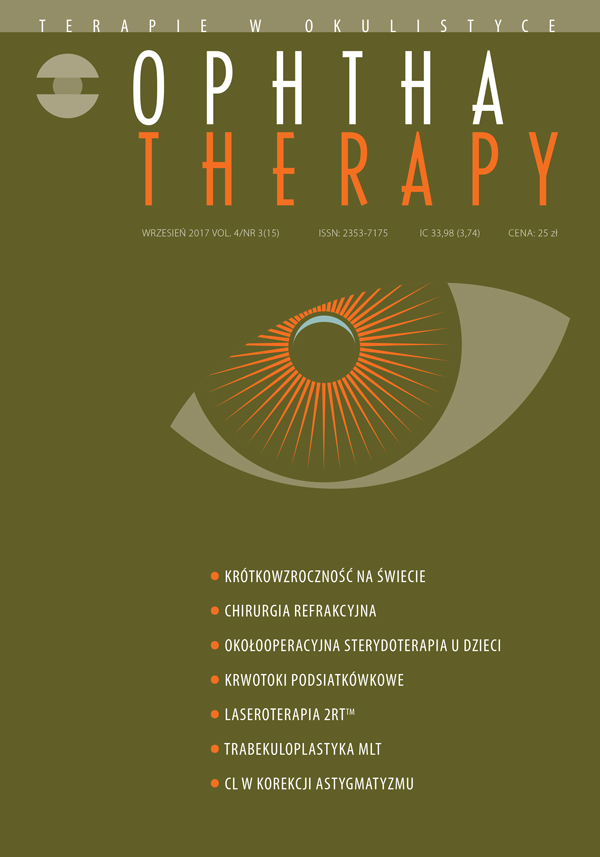Non-compliance in glaucoma patients
Main Article Content
Abstract
Non-compliance in glaucoma therapy lowers the efficacy of the treatment and leads to progression of the disease.
Aim of the study: The aim of the study was to analize the compliance of glaucoma patients with subjective and objective methods.
Material and methods: The study was conducted in a group of 127 glaucoma patients. Subjective compliance was studied with the use of a short survey consisting of 2 questions. Compliance of 28 patients was additionally assessed with the use of an electronic measuring tool Travalert Dosing Aid.
Results: The real compliance measured with Travalert Dosing Aid was much lower than what was declared in the survey (57% vs. 93%; p = 7.896 × 10-16).
Conclusions: Glaucoma professionals must be aware that surveys tend to overestimate compliance. Decisions in glaucoma management should not be based only on patients’ self reported compliance.
Downloads
Article Details

This work is licensed under a Creative Commons Attribution-NonCommercial-NoDerivatives 4.0 International License.
Copyright: © Medical Education sp. z o.o. License allowing third parties to copy and redistribute the material in any medium or format and to remix, transform, and build upon the material, provided the original work is properly cited and states its license.
Address reprint requests to: Medical Education, Marcin Kuźma (marcin.kuzma@mededu.pl)
References
2. Kingman S. Glaucoma is second leading cause of blindness globally. Bull World Health Organization 2004; 82(11): 887-8.
3. European Glaucoma Society. Terminology and guidelines for glaucoma. The fourth edition. Dogma, Savona, Italy 2014: 1-191.
4. Quigley H, Broman A. The number of people with glaucoma worldwide in 2010 and 2020. Br J Ophthalmol. 2006; 90(3): 262-7.
5. Postępowanie w jaskrze – wytyczne Polskiego Towarzystwa Okulistycznego 2017 r. Online: http://pto.com.pl/wytyczne.
6. Cate H, Bhattacharya D, Clark A et al. A comparison of measures used to describe adherence to glaucoma medication in a randomised controlled trial. Clin Trials. 2015; 12(6): 608-17.
7. Olthoff CM, Schouten JS, van de Borne BW et al. Noncompliance with ocular hypotensive treatment in patients with glaucoma or ocular hypertension an evidence-based review. Ophthalmology. 2005; 112(6): 953-61.
8. Osterberg L, Blaschke T. Adherence to medication. N Engl J Med. 2005; 353(5): 487-97.
9. Friedman DS, Jampel HD, Congdon NG et al. The Travatan Dosing Aid accurately records when drops are taken. Am J Ophthalmol. 2007; 143(4): 699-701.
10. Tsai J, McClure C, Ramos S et al. Compliance barriers in glaucoma: a systemic classification. J Glaucoma. 2003; 12(5): 393-8.
11. Kholdebarin R, Campbell R, Jin Y et al. Multicenter study of and drop administration in glaucoma. Can J Ophthalmol. 2008; 43(4): 454-61.
12. Okeke C, Quigley H, Jampel H et al. Adherence with topical glaucoma medication monitored electronically the Travatan Dosing Aid Study. Ophthalmology. 2009; 116(2): 191-9.
13. Sabate E, De Geest S. Adherence to Long-Term Therapies: Evidence for Action. Eur J Cardiovasc Nurs. 2003; 2(4): 323.
14. Bansal R, Tsai J. Compliance/Adherence to Glaucoma Medications – A Challenge. J Curr Glaucoma Pract. 2007; 1(2): 22-5.
15. Sitek A, Turkiewicz J. Co pacjenci myślą o lekarzach? Gazeta Lekarska. 2016; 3: 44-5.

